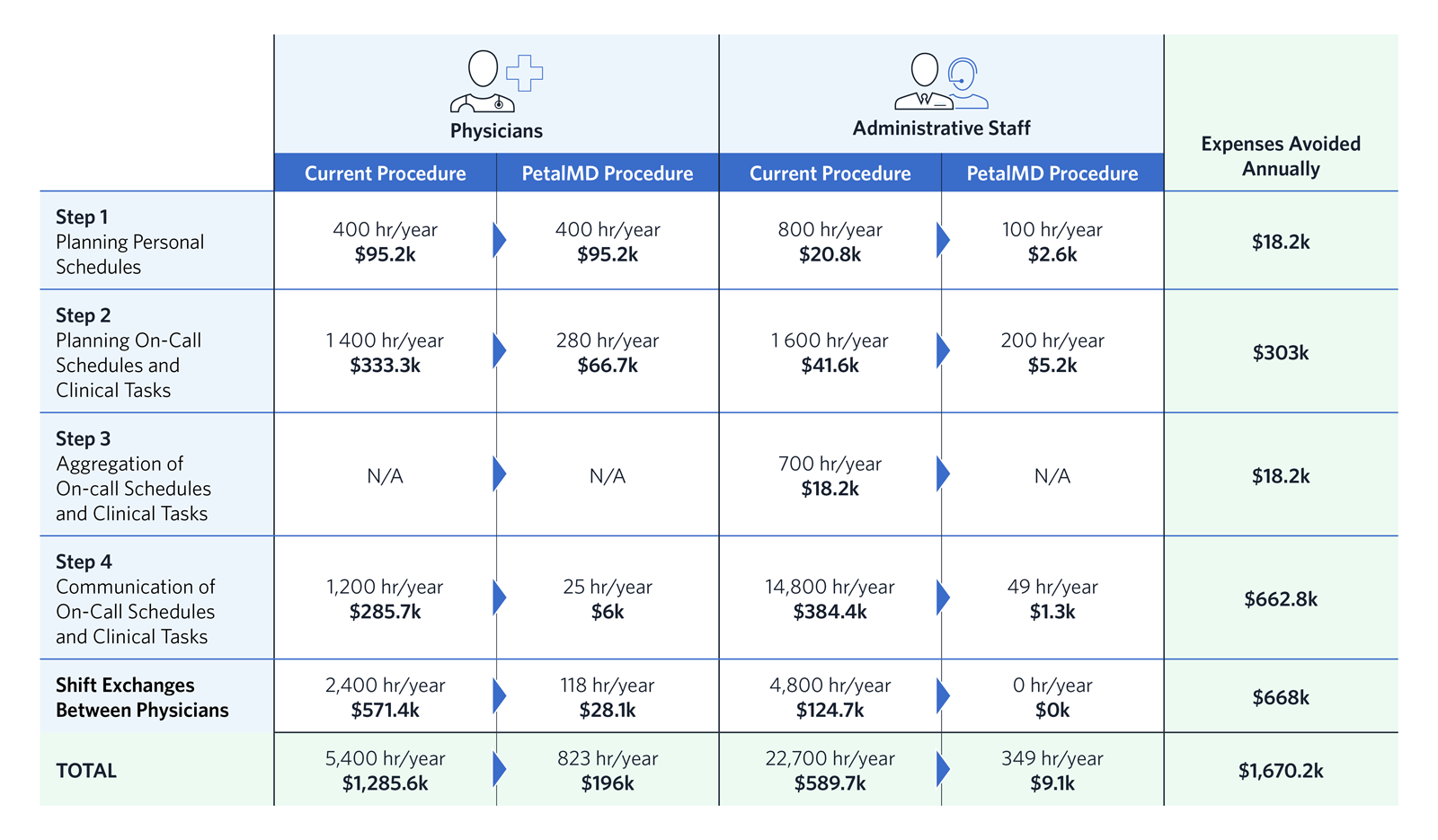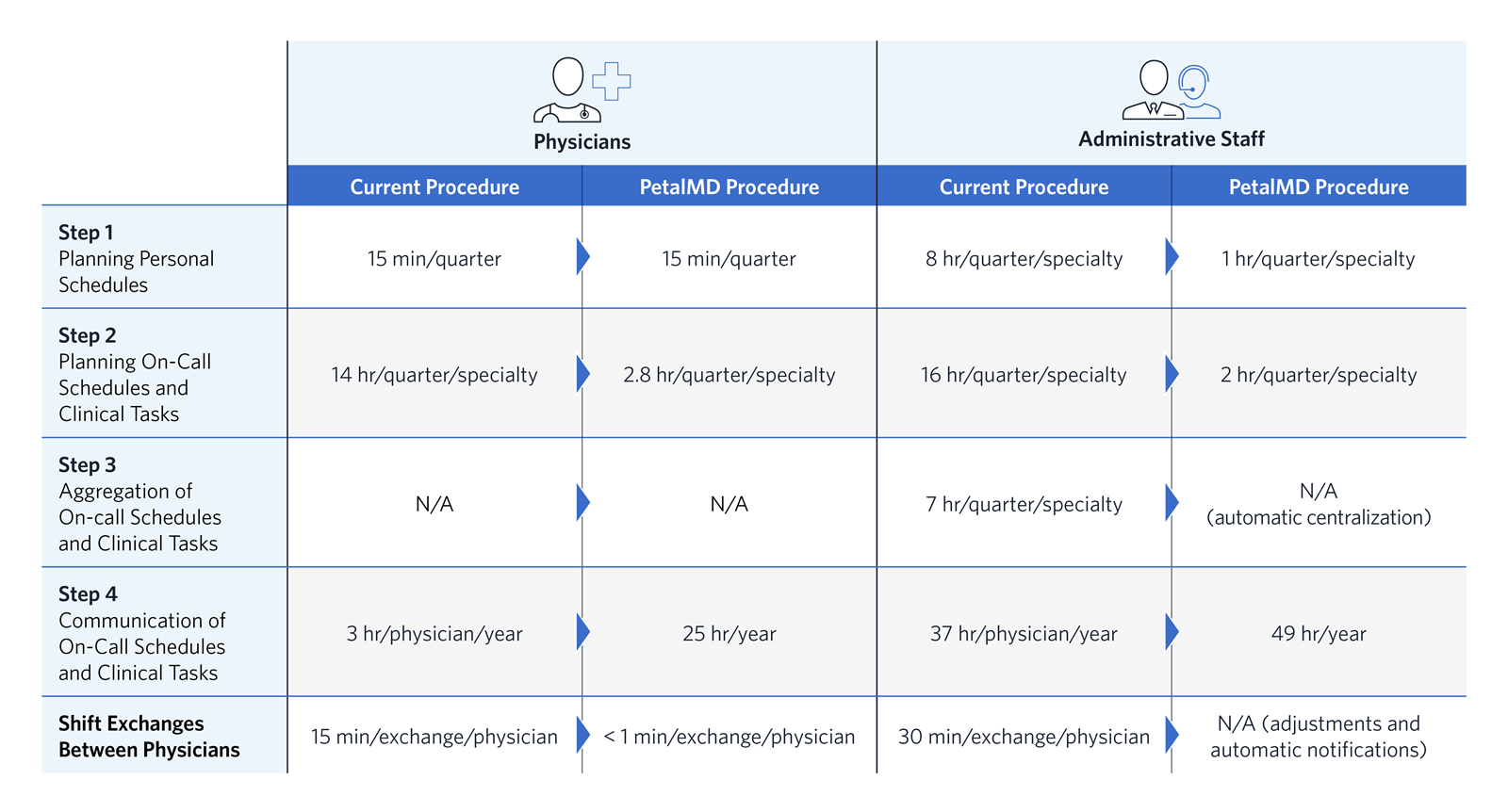
In order to successfully complete their mission of providing quality patient care, hospitals often have to deal with a major challenge: financial resources. Indeed, even if a technology improves the quality of care, some hospitals may not be able to adopt it because they cannot afford it.
Fortunately, some innovative technologies not only improve coordination of care, but also reduce hospital administrative costs. This is the case of the digital platform developed by PetalMD, which centralizes and updates real-time on-call schedules and clinical tasks throughout the hospital to provide an overview of medical activities and shift coverage.
Our team has developed an analytical model that estimates the savings made by hospitals that digitize and centralize physicians' schedules based on testimonials and data from different health facilities. This model enables hospitals to assess the improvement in efficiency in aggregating physician schedules — improvement that can be achieved without hiring additional staff. For instance, a hospital with 25 medical services and 400 physicians could save the equivalent of $1.67 million a year.
Estimated Reduction in Costs Related to Schedule Management in a Hospital with 25 Medical Services and 400 Physicians
How Are the Savings of $1.67 Million per Year Calculated for a Hospital of 400 Physicians?
The savings were calculated based on the number of hours earned by the 400 physicians and the administrative staff in 25 medical units. The hours are then converted into Canadian dollars.
For example, if a physician represents an hourly cost of $240 for the hospital and the PetalMD solution helps him save 10 hours, this would be equivalent to $2,400 in savings. This saving represents the value of the time gain that can be reallocated to value-added tasks.
This process has been divided into four stages in order to estimate the time spent by physicians and administrative staff in managing on-call schedules and clinical tasks. At the same time, we also considered the time required to manage shift change between physicians.
What Costs are Avoided at Each Stage of Schedule Management?
According to our observations, health facilities usually follow the steps outlined below to manage physicians' schedules.
Time Required by Physicians and Administrative Staff to Manage Physicians’ Schedules
Step 1: Planning Personal Schedules
First, each physician sends their availability and restrictions to the person responsible for planning the schedules of the medical service. According to our estimates, each physician allocates on average 15 minutes quarterly to perform this task. As for the hospital administrative staff, it devotes 8 hours per quarter per medical specialty to deliver physicians’ schedule.
For a hospital of 400 physicians, this step costs about $95.2k for physicians and $20.8k for the administrative staff.
Step 2: Planning On-Call Schedules and Clinical Tasks
After having received the availability and constraints of the doctors of the medical service, the planner must gather them in order to distribute the clinical tasks and the on-call shifts for the quarter. They then send the schedule of their medical team to the Medical Affairs in the format that suits them (Excel or Word file, fax, email, etc.). Each planner allocates on average 14 hours per quarter to this step. As for the administrative staff that transmit physicians' schedules and lists to the Medical Affairs, they allocate 16 hours per quarter per specialty to this task.
For a hospital of 400 physicians, this step costs about $333.3k for physicians and $41.6k for the administrative staff.
Step 3: Aggregation of On-Call Schedules and Clinical Tasks
The Medical Affairs receives schedules from all departments in the facility and must gather them into a single format to make them available throughout the hospital. This seemingly simple step, however, requires significant time investment, since the documents are received on different types of media. According to our estimates, this process requires on average 7 hours per quarter per medical specialty for the administrative staff.
For a hospital of 400 physicians, this step costs about $18.2k for the administrative staff.
Step 4: Communication of On-call Schedules and Clinical tasks
The Medical Affairs allocates on average 3 hours per physician per year to all that relates to the communication of schedules. The administrative staff, who is responsible for the reception, transcribing and distribution of on-call schedules and clinical tasks, allocates 37 hours to this step, per physician, per year. The size of the hospital or health organization greatly influences the time required to complete this step.
For a hospital of 400 physicians, this step costs about $285.7k for physicians and $384.4k for the administrative staff.
Shift Exchanges Between Physicians
Physicians frequently make changes to their schedule. Each of these changes requires the physician or his/her assistant to find a replacement, to communicate the change to the planner, and to notify the department of professional services as well as other departments concerned. Since the schedules distributed in the hospital must be manually updated, the administrative staff takes 3 hours per quarter per physicians, added to the 15 minutes already allocated by physicians for each of their shift exchange. According to our observations, physician exchange their shift an average of 6 times per quarter.
For a hospital of 400 physicians, this step costs about $571.4k for physicians and $124.7k for the administrative staff.
What Other Data Was Used in This Analysis?
To achieve an annual savings of $1.67 million, we relied on the reality of a few health facilities and used the following data.

Have a Detailed Picture of the Savings Generated for Each Step
For an overview of how a 400-physician hospital can save $1.67 million by using the platform developed by PetalMD and for a detailed picture of the savings associated with each stage of physician scheduling, do not hesitate to download the free document below. You can also request a custom demo, or contact a specialized adviser.
